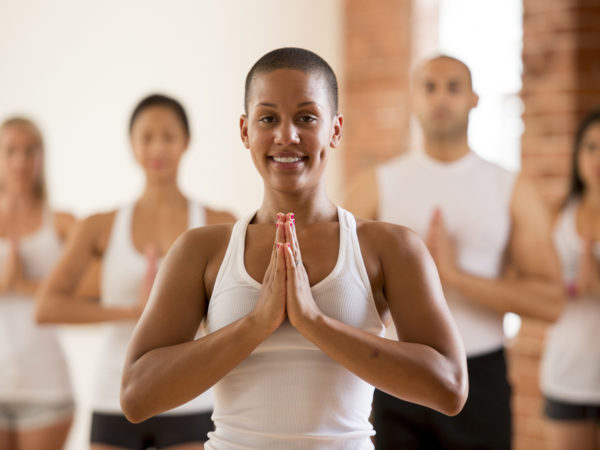Mountain Pose

“The Mountain Pose seems simple, but it’s an important one to master, as it promotes focus and transitions naturally into so many other poses.” – Andrew Weil, M.D.
Description & History
The Mountain Pose is a starting pose for many other yoga poses and is commonly practiced in yoga sessions. As the name suggests, you are strong and standing tall during the pose. While the pose can be performed by itself, it is most commonly used as a resting or transition pose, much like the Child’s Pose. It is used as a starting point for many other poses as it allows the body to integrate the preceding pose with the following one.
The Sanskrit name of Mountain Pose, tadasana, comes from tada meaning mountain and asana meaning posture. In Mountain Pose, the body stands erect with arms at the sides. Some variations incorporate Namaste position where palms of the hands are pressed together in front of the chest and fingers pointing upward. During the pose, focus on balance and breathing as you achieve a connection between mind, body, and spirit.
How to Perform Mountain Pose
- Begin by standing with your big toes touching and your heels slightly apart. Make sure your bodyweight is evenly distributed between both feet and from heel to toe.
- Engage your thigh muscles to straighten your legs and lift your kneecaps. Rotate your hips down by dropping your tailbone toward the floor and lifting your pubis bone toward the sky.
- With your arms at your side, press your shoulder blades into your back and release. Widen your collarbones to open your chest even more but do not extend your rib cage beyond your hips.
- Bring your head to the center of your body so your spine is in alignment from the top of your head to your tailbone. Stare at a point in the distance and release any tension in your head and neck.
- Stay in this position for 30 seconds to one minute with slow, even breaths.
Potential Health Benefits
- Improves posture and spine alignment
- Strengthens muscles of back and abdomen
- Improves balance
- May help relieve sciatica and flat feet
Poor posture is often the cause of musculoskeletal pain. Researchers studied the efficacy of a single yoga session of two poses, one of which was Mountain Pose. The 110 study subjects were split between the 20-minute yoga session and the control group which received a placebo treatment (application of an ultrasound device that was actually turned off). Results published in the Journal of Bodywork and Movement Therapies stated that a single yoga therapy session is an effective form of treatment for various musculoskeletal problems compared to placebo.
Modifications & Variations
Beginners performing the Mountain Pose for the first time may experience difficulty in holding the pose and may lose balance. To counter this lack of balance, spread your feet a few inches to widen your base. Once you have performed the pose a few times with this wider base and increased your balancing ability, you can bring your feet back together again.
Advanced practitioners can enter into the Mountain Pose and do one of two variations to increase the benefits of the pose. One is to bring your arms up from the side of your body into Namaste position with palms of your hands pressed together in front of your chest. Another variation is to close your eyes while performing the Mountain Pose. This can be dangerous if you do not have a strong sense of balance and should be attempted only once you are comfortable with your ability to perform the pose. Done for brief periods, 5-15 seconds, it can be an effective way to practice improving balance.
Precautions
Those who suffer from headaches or low blood pressure should be cautious when performing the pose. If you suffer from foot, leg or hip pain, avoid performing the pose for extended periods of time.
Related Poses
- Standing Forward Bend Pose (Uttanasana)
- Tree Pose (Vrksasana)
- Warrior III Pose (Virabhadrasana III)
- Chair Pose (Utkatasana)
Reviewed by: James Nicolai, M.D., on August 1st, 2013.
Sources
do Rosário, José Luís Pimentel, Larissa Schwarzwälder Orcesi, Fernanda Naomi Kobayashi, Alexandre Nicolau Aun, Iane Tavares Diolindo Assumpção, Gisele Janaina Blasioli, and Érica Sato Hanada. “The immediate effects of modified Yoga positions on musculoskeletal pain relief.” Journal of Bodywork and Movement Therapies (2013).









